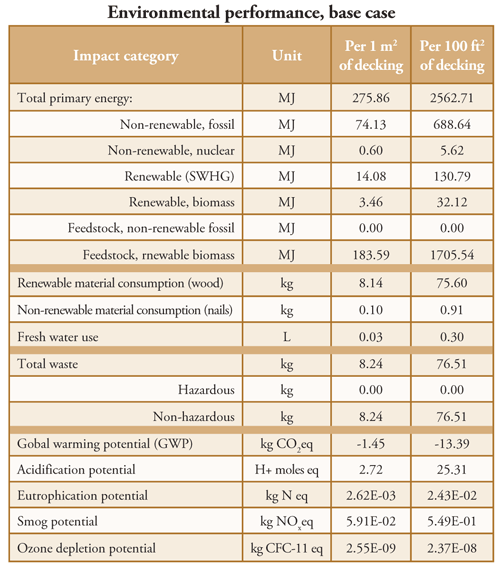Environmental Product Declarations
Close-up: an EPD for Western Redcedar. An EPD for typical western redcedar decking is a 14-page document that begins with brief sections on manufacturer information and product description. In this case, the EPD addresses products from multiple manufacturers and represents an average based on a sample that included two lumber mills in British Columbia, combined with recent secondary data on western redcedar resource extraction from the Athena Institute. The total data represents 20 percent of western redcedar decking production in the year 2007. Product description information includes:
 |
The EPD describes wood decking as a board-type product horizontally applied in a load-carrying capacity and as the final surfacing for an outdoor flat surface attached to a house and typically elevated above the ground. A decking product in the most common size, as specified below, is modeled for this EPD.
- Typical board size: 5/4" x 6" (31.75 mm x 152.4 mm)
- Grade: Average
- Product composition (on the basis of 1 m2 installed decking with a 25-year service life):
Western redcedar lumber: 8.14 kg (oven dry basis)
Optional coating
Stain: 1.25 liters
Fasteners (2½" galvanized nails, No 8 or 10): 0.1 kg per 1 m2 installed decking
- Installed and used according to specifications2. Base case is an uncoated deck. An alternate scenario has regular applications of a stain coating.
The EPD goes on to address the LCA of the decking, noting the organization that performed the LCA, and when and where the data was collected. System boundaries are defined. In this case, the boundaries extend to all production steps from extraction of raw materials from the earth through to final fate of the product at the end of its service life, including all transportation of major inputs to and within each activity stage including the shipment of products to a hypothetical building site location in North America and eventual transportation to landfill. The city of Minneapolis was chosen as the typical building location, as a central location in North America.
Ancillary materials and other materials such as coatings, fasteners, and packaging are included in the boundary, though mass or energy flows less than 1 percent of model flows and less than 2 percent of life cycle impacts are excluded as are human activity and capital equipment. Assumptions for the use phase are stated, such as, the use of water and cleaning solutions is common to all decking types and is excluded.
End-of-life assumptions are spelled out in detail. In the LCA used for this EPD, materials at the end of their service life are assumed to be transported through municipal solid waste collection to inert material landfills, as is estimated by Franklin Associates to be the norm for 70 to 80 percent of construction and demolition debris (USEPA, 1998). Organic materials in landfill decompose into the greenhouse gases methane and carbon dioxide, the methane portion of which may be captured for heat recovery or flaring. The USEPA (2006) estimates that 59 percent of landfills are equipped with gas collection systems and 75 percent of emitted gases are captured; of that, 53 percent is burned with energy recovery and 47 percent is flared. The handling of municipal solid waste is modeled with representative process data provided in the ecoinvent database (Doka, 2007), with electricity-fuel breakdown, energy supply chain, and combustion processes substituted with USLCI data. Wood products are known to not completely decompose in landfill, leaving some or most of the carbon essentially in permanent storage; estimates for the proportion of wood that will decompose vary from very low to the most recent estimate of 23 percent (Skog, 2008).
Environmental performance of western redcedar is based on the U.S. Environmental Protection Agency's TRACI (Tool for the Reduction and Assessment of Chemical and other environmental Impacts) life cycle impact assessment methodology is used to characterize the flows to and from the environment. Impact measures shown include global warming potential, acidification potential, eutrophication potential, smog potential, and ozone depletion potential. A sample of the information relating to environmental performance is presented in the following figure.

The EPD also shows environmental performance of decking with a regular application of stain. "It's important that an EPD represent a product in all its common uses," says Jennifer O'Connor, group leader, Energy & Environment, for the Building Systems Program at FPInnovations, which prepared the EPD. "Because decking is frequently stained, which can have an added environmental burden, we wanted to assure that this common use of western redcedar was accounted for."









